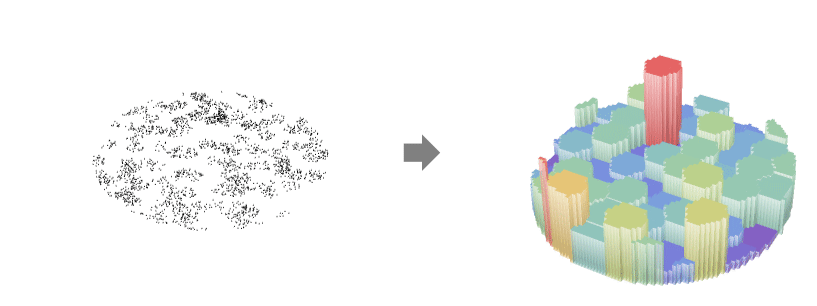HistogramPointDensity
HistogramPointDensity[pdata]
estimates the histogram point density function ![]() for point data pdata.
for point data pdata.
HistogramPointDensity[pdata,bspec]
estimates the histogram point density function ![]() with histogram bins specified by bspec.
with histogram bins specified by bspec.
HistogramPointDensity[bdata,…,…]
estimates the histogram point density function ![]() for binned data bdata.
for binned data bdata.
HistogramPointDensity[pproc,…,…]
computes the histogram point density function ![]() for the point process pproc.
for the point process pproc.
Details and Options




- Point density is also known as point intensity.
- HistogramPointDensity gives a function
 that describes how the number of points
that describes how the number of points  varies per length, area and volume in the observation region
varies per length, area and volume in the observation region  . The integral over the region is the total number of points
. The integral over the region is the total number of points  .
. - HistogramPointDensity is a partition-based estimator of the point density, where the bin specification bspec is used to control the smoothing.
- Histogram point density is typically used to define an inhomogeneous Poisson process or a measure of inhomogeneity.
- HistogramPointDensity returns a PointDensityFunction that can be used to evaluate the density function repeatedly.
- The points pdata can have the following forms:
-
{p1,p2,…} points pi GeoPosition[…],GeoPositionXYZ[…],… geographic points SpatialPointData[…] spatial point collection with observation region {pts,reg} point collection pts and observation region reg - If the observation region reg is not given, a region is automatically computed using RipleyRassonRegion.
- The binned data bdata is assumed to come in the form of SpatialBinnedPointData.
- The point process pproc can have the following forms:
-
proc a point process proc with exact formulas {proc,reg} a point process proc and observation region reg based on simulation - The observation region reg should be a parameter-free, full-dimensional and bounded region as tested by SpatialObservationRegionQ.
- The following geometric and geographic bin specifications bspec can be given:
-
MeshRegion[…] - explicit MeshRegion with cells
"ObservationMesh" discretization of observation region {reg1,reg2, ...} - explicit list of disjoint regions
shape geometric shape depending on the dimension {shape,"Count"n} aggregated bins to approximately n bins {shape,"Measure"ν} aggregated bins of approximate measure ν {shape,"Diameter"d} aggregated bins of approximate diameter d - Possible settings for shape include:
-
"Triangle" triangle bins in 2D "Square" square bins in 2D "Hexagon" hexagonal bins in 2D - The geometric bins can also be created by providing bspec coordinate-wise:
-
n use n bins {w} use bins of width w {min,max,w} use bins of width w from min to max {{b1,b2,…}} use bins [b1,b2),[b2,b3),… Automatic determine bin widths automatically "name" use a named binning method fw apply fw to get an explicit bin specification {b1,b2,…} {xspec,yspec,…} give different x, y, etc. specifications - Possible named binning methods include:
-
"FreedmanDiaconis" twice the interquartile range divided by the cube root of sample size "Knuth" balance likelihood and prior probability of a piecewise uniform model "Scott" asymptotically minimize the mean square error "Sturges" compute the number of bins based on the length of data "Wand" one-level recursive approximate Wand binning - All the bins are trimmed to intersect with the observation region.


Examples
open allclose allBasic Examples (2)
Create a SpatialPointData:
Visualize the density estimation:
Compute histogram point density for a list of geographic points:
Scope (5)
Create a homogeneous univariate SpatialPointData:
Compute point density function using different bin shapes:
Visualize using values at random locations:
Histogram point density of clustered data:
Compute histogram point density from data:
Histogram point density for a hardcore process:
Compute histogram point density from data for various bin diameters:
Compare bin shape specifications:
Define a mesh region and polygon composite region:
Allowed bin specifications on the surface of the Earth:
Applications (1)
Get the data of rat sightings in New York City:
List column keys to find locations column:
Extract geo locations, delete missing and create SpatialPointData:
Compute histogram point density:
Visualize the areas of prevalence of rat sightings in NYC on a sample of the locations:
Properties & Relations (1)
HistogramPointDensity is related to Histogram with bin height specification "Intensity":
Specifying bin width in computation of histogram point density:
Compare the density function to the intensity Histogram with the same bin width:
Compute histogram point intensity:
Compare plot of the density function with the Histogram3D of the data:
Text
Wolfram Research (2020), HistogramPointDensity, Wolfram Language function, https://reference.wolfram.com/language/ref/HistogramPointDensity.html.
CMS
Wolfram Language. 2020. "HistogramPointDensity." Wolfram Language & System Documentation Center. Wolfram Research. https://reference.wolfram.com/language/ref/HistogramPointDensity.html.
APA
Wolfram Language. (2020). HistogramPointDensity. Wolfram Language & System Documentation Center. Retrieved from https://reference.wolfram.com/language/ref/HistogramPointDensity.html